Content
All issues / Volume 16 (2022) / Issue 2 (February)
Tamas Tabi
Vol. 16., No.2., Pages 115-115, 2022
DOI: 10.3144/expresspolymlett.2022.9
Vol. 16., No.2., Pages 115-115, 2022
DOI: 10.3144/expresspolymlett.2022.9
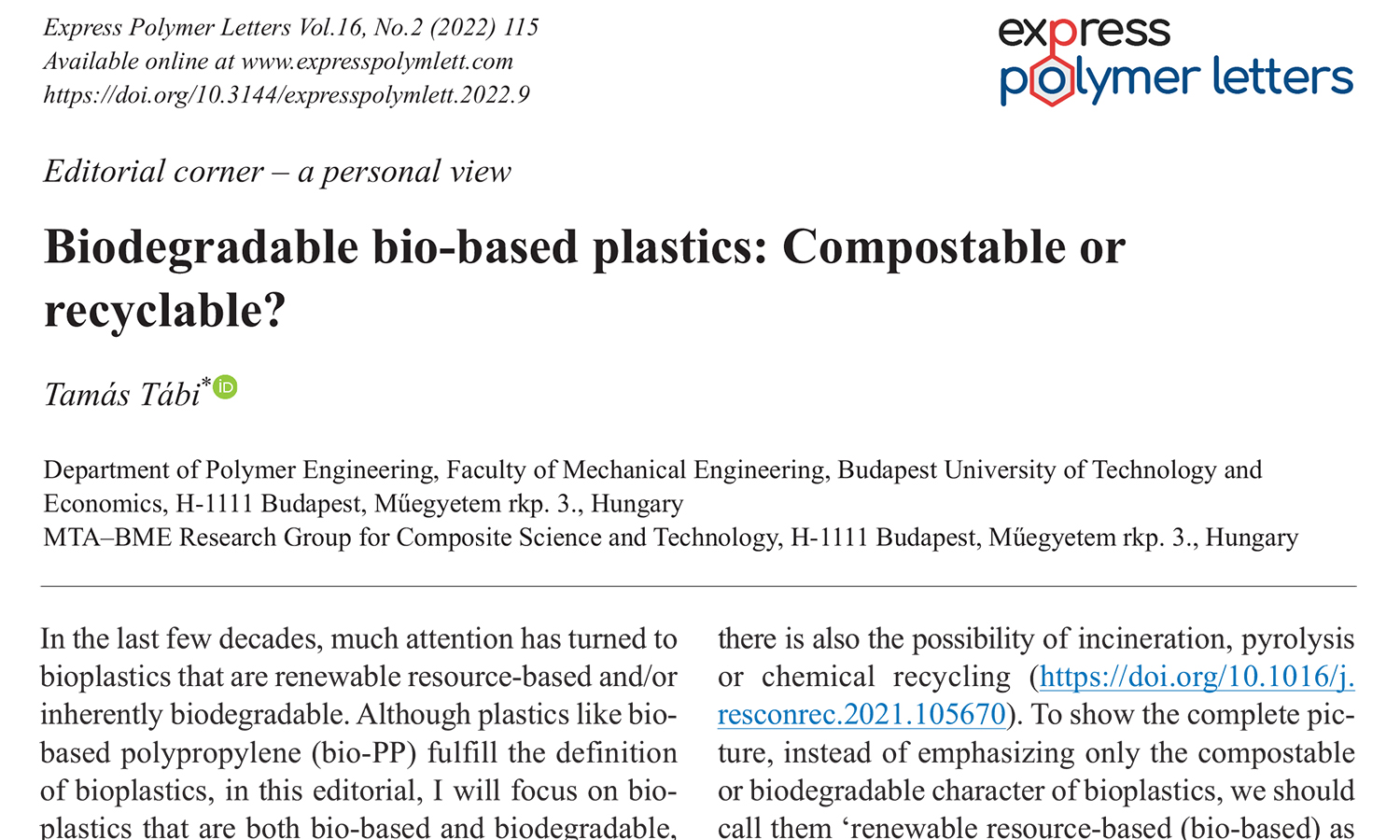
This is an editorial article. It has no abstract.
Shiho Kuwashiro, Nozomu Nakao, Satoshi Matsuda, Takeshi Kakibe, Hajime Kishi
Vol. 16., No.2., Pages 116-129, 2022
DOI: 10.3144/expresspolymlett.2022.10
Vol. 16., No.2., Pages 116-129, 2022
DOI: 10.3144/expresspolymlett.2022.10
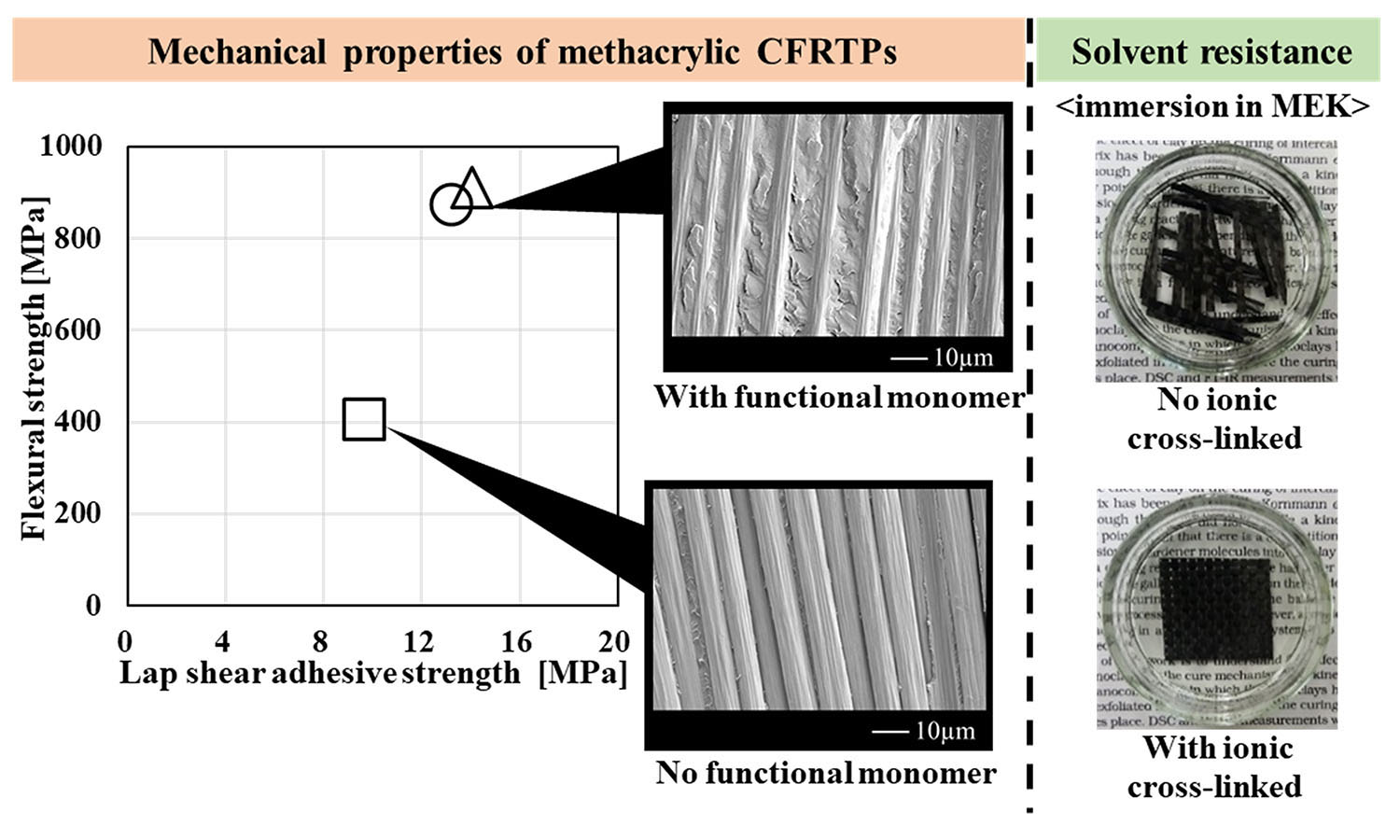
Methacrylic copolymers have high potential as matrix polymers for carbon fiber reinforced thermoplastics (CFRTPs) due to their superior mechanical properties and the versatility of the monomers. However, the methacrylic copolymers have low solvent resistance, compared to epoxy, polyamide, and polypropylene, due to their un-cross-linked amorphous structure. Therefore, an improvement of the solvent resistance by the introduction of metal salts into methacrylic copolymer matrices for CFRTPs was investigated. Infrared spectroscopy, dynamic mechanical analyses and small-angle X-ray scattering clarified that an ionic cross-linked structure was formed. Low-viscosity mixtures of the methacrylic monomers with the metal salts, as a precursor of the matrices for CFRTPs, were easily impregnated into CF fabrics and were then copolymerized within the CF fabrics. Both the flexural strength and shear adhesive strength of the CFRTPs using the in situ polymerized methacrylic ionomer cross-linked with sodium ions were sufficiently high, even after 12 h immersion in methyl ethyl ketone.
Robert Keqi Luo
Vol. 16., No.2., Pages 130-141, 2022
DOI: 10.3144/expresspolymlett.2022.11
Vol. 16., No.2., Pages 130-141, 2022
DOI: 10.3144/expresspolymlett.2022.11
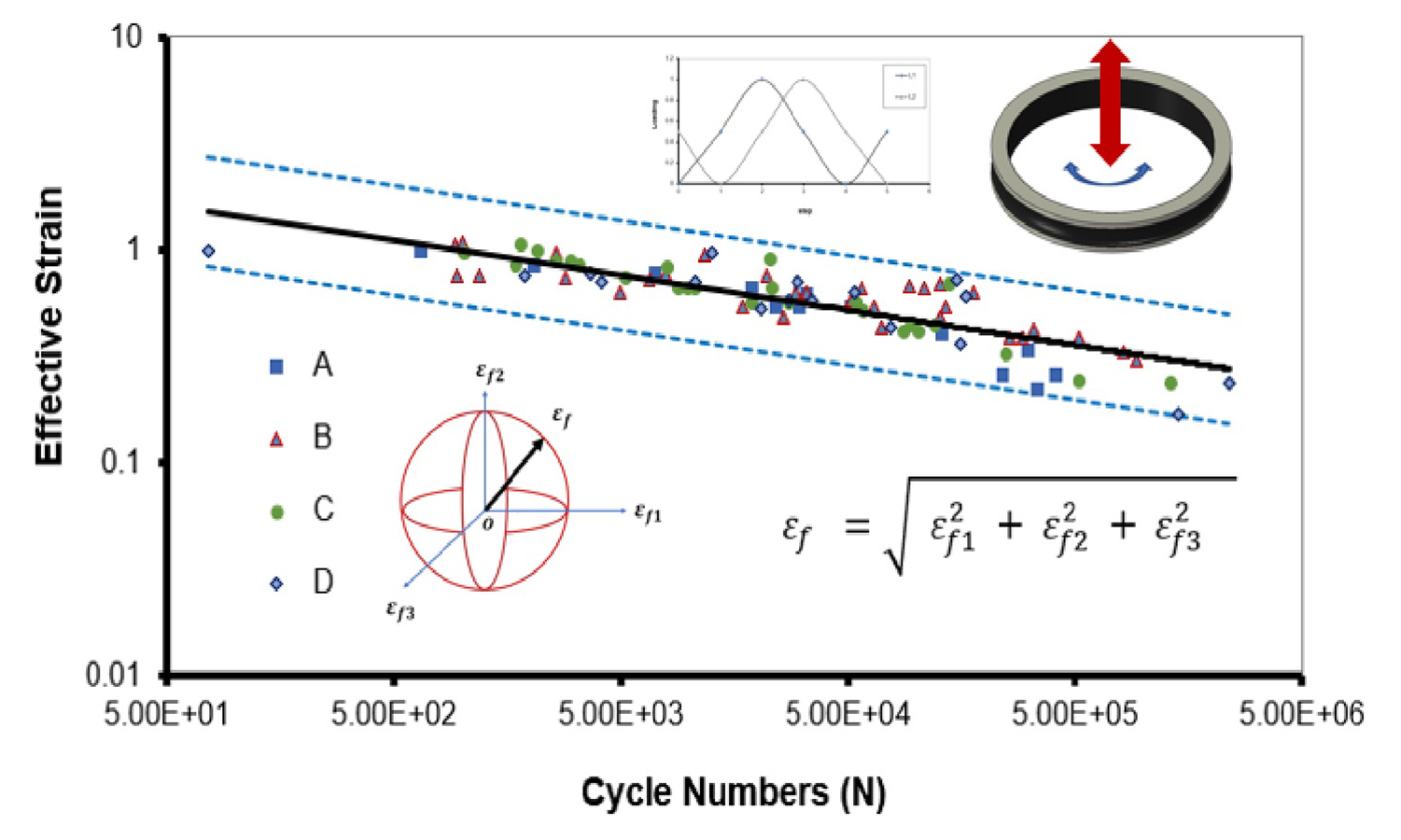
The effective strain criterion, unifying multimode and multiaxial loadings to a single parameter and being expressed in analytical form with no need to rotate a plane to search the maximum damage parameter, is proposed for the fatigue design of anti-vibration components. The validation procedure was performed on 90 cases in two aspects: fatigue damage and crack orientation. All predicted fatigue cracks were located at the places where the effective strain reached its maximum and was consistent with the experimental observations. The failure planes predicted correlated with the experimental measurement. The S–N curve covered over 102 to 2.4·106 cycles and achieved high accuracy with the scatter-band of 1.8. The proposed approach was applied to two non-proportional loading cases (one in a phase angle 45° and the other in a phase angle 90°). The results seemed to indicate the suitability of the approach for the non-proportional loading calculations. It would be possible to combine the proposed approach with the critical plane method in non-proportional loadings: using the proposed approach to find the critical loading range and then using the critical plane method to determine the maximum values of the required damage variables. Both the proposed concept and the obtained S–N curve would be beneficial in rubber fatigue design. More engineering cases may be needed to verify this approach further.
Wanjing Zhao, Xianwu Cao, Jinshu Huang, Jiangwei Wen, Yun He, Junwei Zha, Robert Kwok Yiu Li, Wei Wu
Vol. 16., No.2., Pages 142-151, 2022
DOI: 10.3144/expresspolymlett.2022.12
Vol. 16., No.2., Pages 142-151, 2022
DOI: 10.3144/expresspolymlett.2022.12

There is a great demand for low dielectric materials as insulating interlayers in large-scale integrated circuit development. However, it is still a huge challenge to reduce the dielectric permittivity of polymers while maintaining excellent thermal stability and mechanical properties. In this work, the fluorinated polyimides (PIs) in combination with a micro-branched crosslinking structure were prepared successfully by introducing different amounts of 1,3,5-tris(4-aminophenyl) benzene (TAPB) to obtain ultra-low dielectric permittivity. The results revealed that PI film containing 2 mmol TAPB had the lowest dielectric permittivity (2.47) and dielectric loss (0.008) at 1 MHz due to the fluorine atoms and the micro-branched crosslink structure, which not only decreased the molecular polarizability but also increased the free fractional volume. In addition, PI film containing 2 mmol TAPB had the highest tensile strength of 106.02 MPa with an elongation at a break of 15.1% because the presence of TAPB effectively promoted the connection between PI molecular chains, resulting in the inhibition of the molecular mobility. The incorporation of TAPB also enhanced the thermal stability and ultraviolet light-shielding performance of PI films. This method paves the way for the development of PIs with ultra-low dielectric permittivity for the electronic industry.
Sajjad Daneshpayeh, Ismail Ghasemi, Faramarz Ashenai Ghasemi, Valiollah Panahizadeh
Vol. 16., No.2., Pages 152-170, 2022
DOI: 10.3144/expresspolymlett.2022.13
Vol. 16., No.2., Pages 152-170, 2022
DOI: 10.3144/expresspolymlett.2022.13
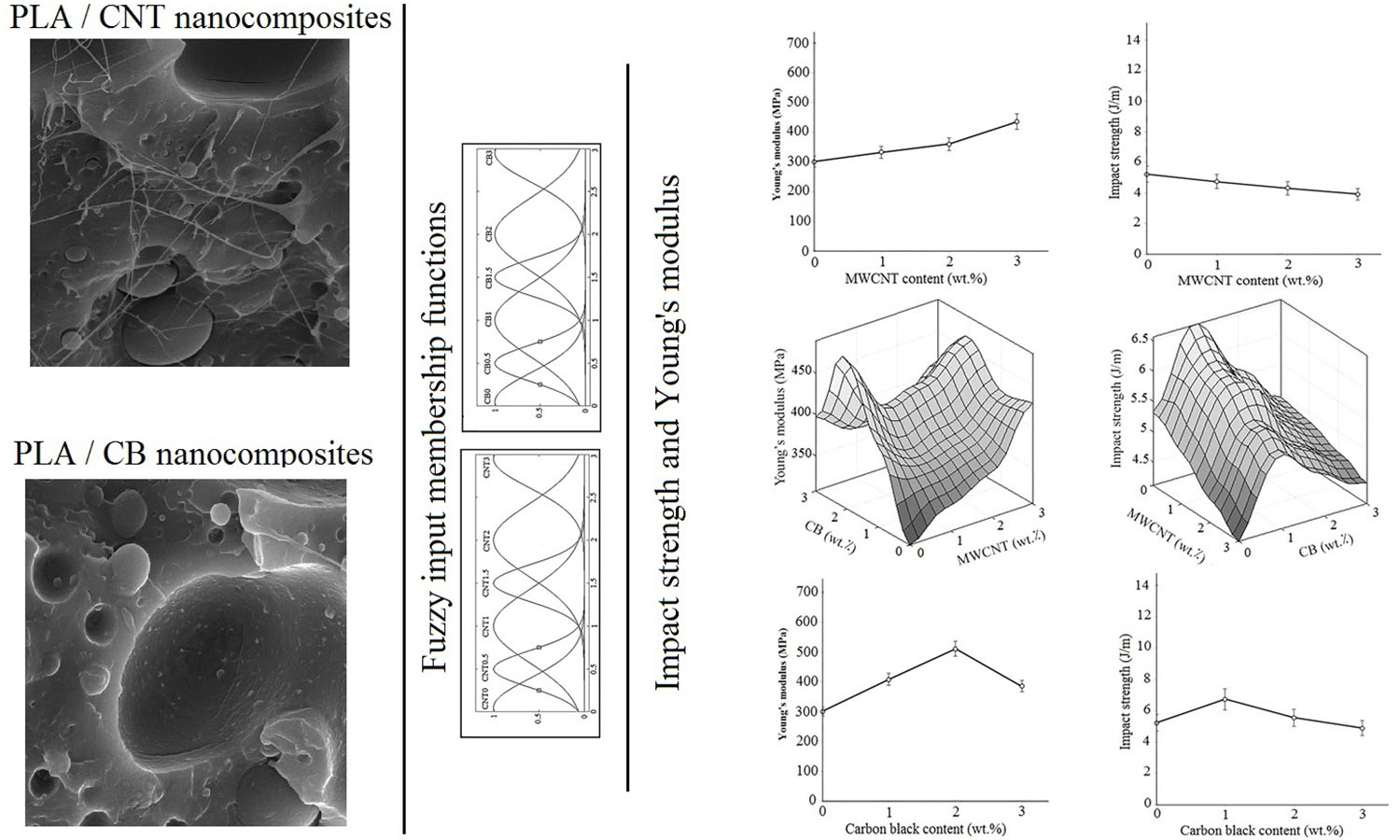
Using filler and impact modifiers for balancing stiffness and toughness properties is a common strategy for modification of polymer matrices’ performance. Nanocomposites based on poly lactic acid/polyolefin elastomer/including multiwalled carbon nanotubes/carbon black nanoparticles (PLA/POE/MWCNTs/CB) were produced using an internal mixer. Fuzzy rule- based system (FRBS) was applied to predict and simulate of mechanical properties of the samples. The fieldemission scanning electron microscopy (FESEM) was applied to determine the state of nanofillers distribution. The FESEM images showed that the carbon black and MWCNTs individually were well distributed. But, the simultaneous addition of nanofillers by more than 1 wt% from each one led to their agglomeration. The results illustrated that the presence of MWCNTs and carbon black separately and simultaneously led to an increase in tensile strength and Young’s modulus. The simultaneous presence of them led to an improvement in impact strength by 30%. Also, by incorporating POE into the PLA matrix, a significant increment in impact strength was obtained by 110%. The obtained surface plots from FRBS revealed that there is an interaction between nanofillers effects on the mechanical properties. Finally, a good agreement between the predicted mechanical properties using FRBS and evaluation tests led to extract accurate models with proper R2 and standard error for all responses.
Mauricio Sanchez-Luna, Miroslav Otmar, Libor Kobera, Jan Zitka, Vladimir Escobar-Barrios
Vol. 16., No.2., Pages 171-183, 2022
DOI: 10.3144/expresspolymlett.2022.14
Vol. 16., No.2., Pages 171-183, 2022
DOI: 10.3144/expresspolymlett.2022.14

The indirect sulfonation, via chloromethylation, of poly(styrene-(ethylene-butylene)-styrene) (polySEBS), under mild conditions, is here reported as an alternative route for the conventional use of chlorosulfonic acid. This indirect sulfonation reaction is an effective route to insert sulfonic groups in the aromatic rings of SEBS to impart a proton exchange capability. The chloromethylated polySEBS was chemically modified by the isothiouronium grouPp, afterward hydrolyzed and oxidized to generate sulfonic acid groups selectively into the aromatic portion (polystyrene) of the polySEBS, to a great extent. The chloromethylated and sulfonated polymeric membranes were characterized by NMR, FT-IR, water uptake, TGA, ion exchange capacity (IEC), and ion conductivity. The obtained results show that as the oxidation time increased in performic acid, the water uptake achieved up to 79.6% due to the conversion of isothiouronium to the sulfonic acid groups into the polymer structure. Furthermore, the sample after 7 hours of oxidation reaction (sSEBS-7H) showed 59% of sulfonation, determined by RMN, and had an IEC value of 1.46 meq/g and also an ion conductivity value of 18.7 mS/cm at RT, which are 46 and 75% higher than those of Nafion 115, a commercial polymer conventionally used for proton exchange membranes (PEM). Thus, the as-prepared sSEBS-7H membrane, via chloromethylation, can be used for PEM since it exhibits good ionic conductivity and structural stability.
Viorica Gaina, Oana Ursache, Constantin Gaina, Irina Rosca, Ana-Lavinia Vasiliu
Vol. 16., No.2., Pages 184-196, 2022
DOI: 10.3144/expresspolymlett.2022.15
Vol. 16., No.2., Pages 184-196, 2022
DOI: 10.3144/expresspolymlett.2022.15
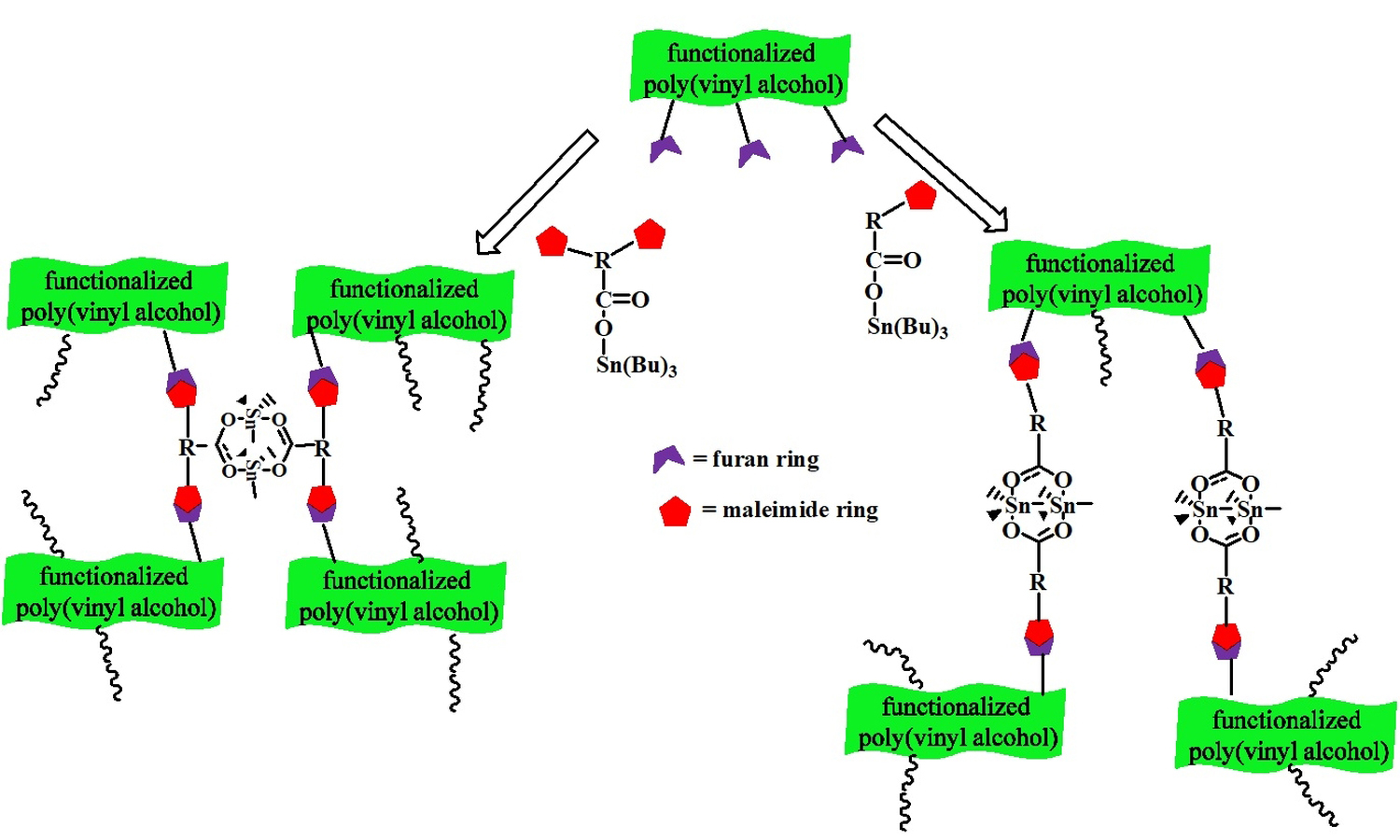
In the present work, new cross-linked networks based on furfural-functionalized poly(vinyl alcohol) (PVF) and maleimide compounds containing tributyltin groups were synthesized. The networks were obtained both as films and porous membranes. The structure of the compounds was confirmed by ATR-FTIR spectroscopy, and the morphology of the films/microporous membranes was investigated using scanning electron microscopy measurements (SEM), the differences between the films and membranes being evidenced. The mechanical performance and thermal stability of the membranes were examined by dynamic mechanical analysis (DMA) and thermogravimetry analysis (TGA), respectively. In addition, their water absorption and antimicrobial properties were thoroughly discussed. The antimicrobial activity of furfural-functionalized poly(vinyl alcohol) was significantly improved by its reaction with compounds containing tributyltin groups.
Recent progress on polymer scaffolds production: Methods, main results, advantages and disadvantages
Thais Larissa do Amaral Montanheiro, Vanessa Modelski Schatkoski, Beatriz Rossi Canuto de Menezes, Raissa Monteiro Pereira, Renata Guimaraes Ribas, Amanda de Sousa Martinez de Freitas, Ana Paula Lemes, Maria Helena Figueira Vaz Fernandes, Gilmar Patrocinio Thim
Vol. 16., No.2., Pages 197-219, 2022
DOI: 10.3144/expresspolymlett.2022.16
Vol. 16., No.2., Pages 197-219, 2022
DOI: 10.3144/expresspolymlett.2022.16
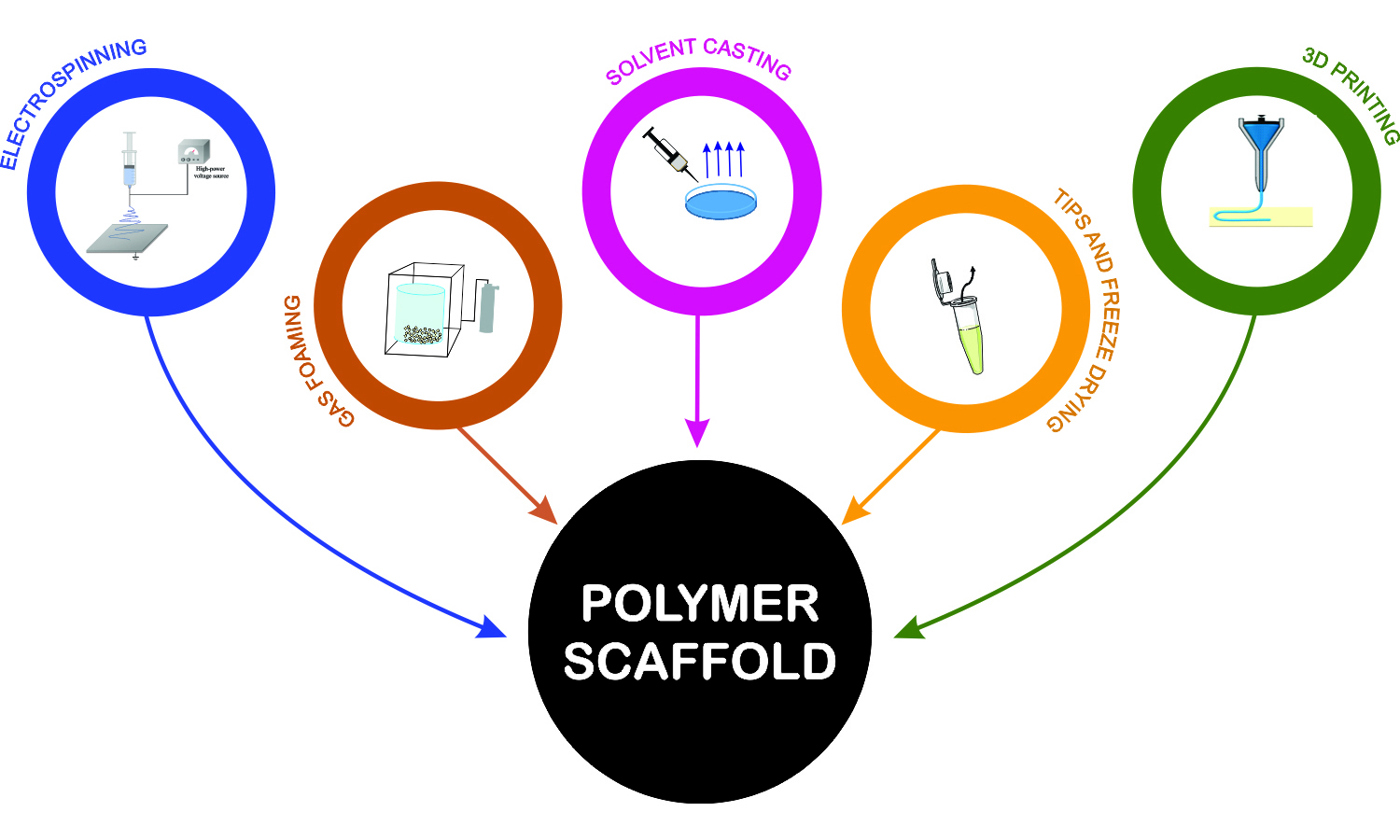
Porous polymeric scaffolds provide a physical substrate for cells to attach and proliferate, allowing the formation of new tissue. These materials are broadly used in the tissue engineering field due to their ability to mimic native tissue. Each application requires specific morphologies and resistance, among other several features. To accomplish these requirements, various techniques are available, each one with its advantages and disadvantages. Among the most relevant techniques are salt leaching, solvent casting, gas foaming, thermally induced phase separation, freeze-drying, electrospinning, thermally induced self-agglomeration, and three-dimensional (3D) printing. In this review, a brief and simple explanation of each method is described, along with some recent results and each technique’s advantages and disadvantages. It is expected that this review will bring important guidance in the production of polymer scaffolds for tissue engineering.


